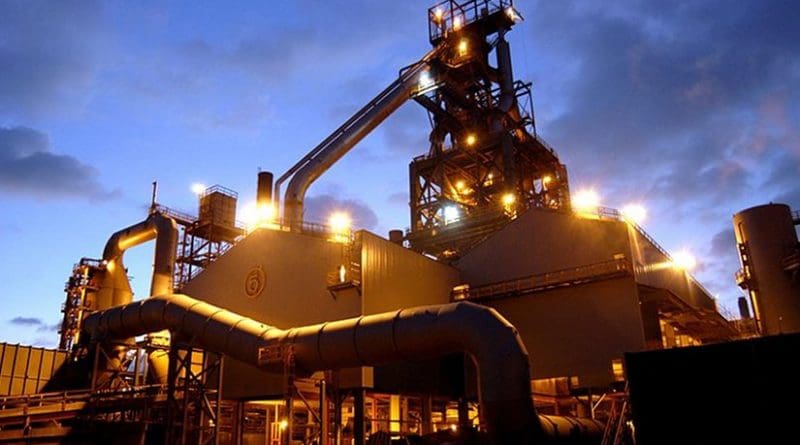Should Indian Steel Companies Expand Or Consolidate? – OpEd
Although installed capacity of the Indian steel industry stood at about 128 million tonne on March 31, 2017, the actual operational capacity is lower, since the capacity utilization level of stressed steel units are lower than the industry average of about 75-80% in FY2017.
Though the operating margin of 18 large and mid-sized steel companies in India, accounting for around 60% of the domestic installed capacity, marginally improved in the fourth quarter of 2016-2017, the overall financial performance of the Indian steel sector remained dismal, as reflected by the level of total debt to operating profit before interest, tax, depreciation and amortization.
Total exposure of the banks to the Indian steel sector stood at Rs. 3.13 lakh crore as on March 31, 2016. There have been significant rise in stressed accounts in domestic steel sector with gross non-performing assets (NPAs) of about Rs. 1.15 lakh crore as on March 31, 2016, roughly about 37% of the total exposure.
Five out of the twelve companies, which have been referred under insolvency resolution process in respect of a default, under provisions of Insolvency and Bankruptcy Code (IBC) 2016, are from the iron and steel sector with total debt of about Rs. 1.4 lakh crore as on March 31, 2016. These five steel companies together contribute about 16% to India’s installed steel production capacity.
Profitability and coverage indicators of these steel companies account hit a low in FY2016 due to several reasons including commodity price melt down and cheaper import.
Proposed expansion plans in steel sector
The high debt and other matrix of the several steel companies are cause for high concern.
Despite the huge debt, rising bad loans and uncertainty over demand, a few steel companies have announced capacity expansion proposals to protect their market share, in case the anticipated demand from infrastructure projects materializes, as envisaged by the Government of .India
As per the industry standard, a greenfield project of one million tonne per annum of steel capacity calls for an investment of $1 billion (about Rs.6,400 crore).
Obviously, such expansion plans of steel industry are a calculated risk in the present conditions. Can the debt ridden Indian steel industry afford to take such a risk is the question.
Tata Steel — Case Study
Tata Steel has a debt of Rs.85,000 crore and it registered an EBITDA of about Rs. 17,000 crore last fiscal.
The company faces several issues such as the problems faced with regard to the investment in steel industry in Europe and problems due to closure of it’s mines and drop in the steel prices. Closure of mines and steel prices dropping to decade-low levels are some of the challenges that resulted in rise in debt.
In spite of such stressful conditions and huge debt, Tata Steel is adding one million tonne per annum capacity to its 10 million tonne per annum Jamshedpur plant through brownfield expansion.
Tata Steel has also decided to enhance production capacity at its Kalinganagar steel plant in Odisha to 8 million tonne per annum, from 3 million tonne per annum.
Plans of JSW steel
Recently, JSW Steel said that it would spend Rs.15,000 crore at its Dolvi plant in Maharahstra to double capacity from 5 million tonne per annum to 10 million tonne per annum by 2020.
The overall debt of JSW Steel presently is around Rs.40,000 crores.
Why expand and not consolidate?
The Indian steel sector face grim issues due to weak demand and overcapacity situation. The huge debt burden has made their future scenario uncertain.
The Indian steel industry does not seem to have any convincing and time bound action plans to come out of the present difficult and stressful conditions
In such circumstances, one would expect that the difficult financial conditions and the threat of insolvency proceedings against the steel companies with stressed accounts would lead to the units taking efforts to consolidate the existing conditions, instead of embarking on capacity expansion.
To the discerning observers, such steps for capacity expansion at the present juncture would look like an adventure oriented strategy. Many investors in the steel industry are bound to question the logic of such expansion plans, which may possibly take the units into more difficult condition .
One would also expect that the present scenario would prompt stronger and cash rich steel players abroad to bid for the assets of the stressed Indian steel companies at attractive valuations and increase their market share. Facing such eventuality , the existing steel producers opting for the expansion plans in spite of the huge debts of the units, is strange and unconvincing.
What stand for financial institutions?
It is necessary that for financial institutions and banks, whose financial conditions have been destabilized due to huge loan defaulters, should make it clear to the steel companies that they can not take the support of the financial institutions for granted, if they would choose to carry out massive investment to build more capacities.
The lenders can not any more take calculated risk in extending loans to the stressed steel companies, even though the steel companies may have no hesitation in taking such calculated risk.

